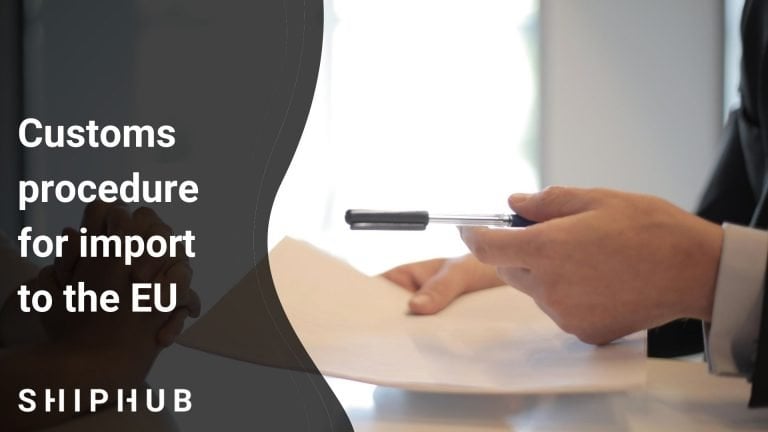The import of goods is closely tied with carrying out customs clearance formalities. If you import goods from a non-European Union country, like Vietnam or China, to an EU Member State, you are an importer by EU’s regulations. You are not an importer if you move goods from one EU country to another. One of the most important importer’s obligations is to clear the goods through customs. We present what customs procedure for import to the EU is and what documents the importer should prepare.
Types of customs clearance for import to the EU
Customs clearance is the act of passing goods through customs, enabling the goods to be placed on the market. There are three types of customs clearance:
- free circulation – the goods obtain the status of Union goods and can be placed on the EU market
- temporary admission – the goods are brought temporarily to the EU with total or partial relief from import duty. It includes goods intended for exhibitions, trade fairs, contests, etc. The maximum period is two years
- inward processing – for manufacturing or repair. Those goods are not subject to import duty and other taxes
- storage – while in storage, goods are not subject to import duties and other charges
What does a customs broker do?
Customs broker deals with the customs formalities at the customs office on behalf of the importer or exporter. A customs agency is not the same as a customs office – you can take advantage of a professional customs broker’s services. Still, the customs authority must handle the goods. Simply put, the customs broker is the intermediary between the importer and the customs authority. Within the EU, there is no customs broker license.
The customs broker can for the importer provide the following services:
- preparing and submit the documents needed for the clearance of goods
- assessing commercial documents
- verify the CE mark
- drawing up an excise tax declaration
- calculating the amount of import duties
- verifying customs declaration
Customs clearance and custom duties
One of the main aims of customs clearance, apart from determining compliance with the law and international agreements of goods, is the payment of duty. The duty is imposed on goods originating in a third country, i.e., outside the European Union. It must be paid when crossing the customs border. The duty does not apply to goods moved within the EU. The effect of the duty is increased prices for the consumer.
There is a customs tariff common to all Member States in the EU. In most cases, it is a percentage of the customs value of the goods (ad valorem). In some cases, weight also determines the amount of duty.
You can check the duty rates in the tariff systems: TARIC – Integrated Tariff of the European Communities and applicable in the Member State of destination. For example, in Poland, it is Customs Integrated Tariff Information System ISZTAR, in Germany – Elektronischen Zolltarif (EZT-online). National systems include information on rates of VAT and excise duty.
The amount of customs and tax duties
When importing, you do not only have to pay the customs duties. You have to pay value-added tax (VAT) and other taxes, like excise duties.
The customs duty is calculated based on the sum of the goods transported outside the European Union and the customs value. In other words, the specified duty rate for the product is multiplied by the amount of the order value and shipping costs.
The basis for calculating VAT is the customs value, previously calculated customs duties, and transport (freight), both outside the EU and within the EU. The sum is multiplied by the amount of VAT, e.g., 23%. VAT varies within the Member States.
The sum of the VAT amount and customs duties is paid when carrying out clearance of goods.
Making customs clearance
Customs clearance is carried out so that the goods can be, for example, released for free circulation. Through the procedure, the product becomes a Union good. You can complete a custom clearance:
- in writing, by completing the SAD
- electronically, by sending a file in the electronic system
- orally, but it is only applicable if the goods are not intended for free circulation
- by performing another action, e.g., going through the green channel “nothing to declare”
Customs procedure for import to the EU
Customs procedure involves the following activities:
- Filling out the Entry Summary Declaration (ENS). The document is submitted electronically in advance to the import operation. The deadline for lodging the ENS:
- road freight: at least 1 hour before arrival
- short sea shipping: at least 2 hours before arrival
- less than 4 hours short-haul flights: at least by the actual time of take-off of the aircraft
- 4 hours or more long-haul flights: at least 4 hours before arrival at the first airport in the customs territory of the EU
- bulk maritime cargo: at least 4 hours before arrival
- ocean freight container: at least 24 hours before loading commences in the foreign port
- After the arrival of the goods, submission of a customs declaration. You have to carry out the formalities using your Economic Operator Registration and Identification (EORI) number.
- Inspection of customs documents by customs authorities. Documents are listed below.
- Inspection of means of transport and the goods.
- Collection of customs duties, other taxes, and fees.
- Release of the goods, thus they can cross the customs border. Products can be placed on the market.
Customs procedure for import to the EU: required documents
Below we present the mandatory documents for clearing the goods.
- A commercial invoice which is obtained from the exporter. A proforma invoice is usually not accepted. It includes data such as:
- date of issue
- invoice number
- name and address of both the exporter and importer
- product name and quantity
- the unit value (given in a specific currency)
- unit of measure: net and gross weight of the goods
- the origin of the goods
- total invoice value and currency of payment
- Incoterms delivery terms
- means of transport
- Certificate of origin issued by the exporter. It helps to set the amount of the duty and allow the importer to claim to a tariff quota/relief from duty.
- Packing List (P/ L), if the gross and net weight has not been shown in the invoice. Data in P/L:
- date of issue
- number of the freight invoice
- data of the shipper and consignee
- type and number of packages
- content of each package
- the net and gross weight of goods (unit and total)
- conditions of delivery
- Bill of Lading (B/L, BOL) is the basic document regulating the legal relationship between the shipowner and the authorized holder of the bill of lading. It is obtained from the shipping company and must be delivered to the destination port for the goods to be collected. The bill of lading is not a contract for the carriage of goods. Data included in the bill of lading:
- bill of lading conditions on the first page
- shipper’s data
- consignee’s data
- details of the company or person to be notified of the arrival of the container
- container number
- quantity, type, and weight of goods
- additionally, you can put other important information, such as the information at the bottom: FREIGHT COLLECT (transport costs covered by the consignee) or FREIGHT PREPAID (the shipper covers costs)
- Instead of B/L – Sea Waybill (SWB), a non-transferable shipping document that proves the conclusion of a shipping contract and the receipt of goods. Unlike B/L, the consignee does not have the right to dispose of the cargo.
- For airfreight, the Air Waybill (AWB) is used, which confirms the conclusion of the transport contract. It obliges the carrier to deliver the cargo to a specific place.
- In the case of rail freight, the CIM/SMGS rail transport contract.
Documents required for certain types of products
Additional documents required depending on the type of goods:
- CE ‘certificate’, test reports, and a declaration of conformity for some imported goods. These documents mean that the product complies with the New Approach Directives. Here is a list of some products that must bear a CE mark:
- toys for children under 14 years of age
- appliances burning gaseous fuels
- explosives for civil uses
- devices and protective systems intended for use in potentially explosive atmospheres
- household refrigerators and freezers
- hot-water boilers
- low voltage devices/electrical appliances
- machinery
- medical devices
- measuring instruments
- noise emission in the environment
- personal protective equipment
- pressure equipment
- radio equipment
- CITES certificate for the import of specimens of fauna and flora. It applies to animals (alive or not), plants, and their parts, as well as other goods containing products derived from plants or animals.
- In terms of movements of excise goods, document Administrative Accompanying Document (AAD) is required. It contains information describing a consignment, its origin, its destination, its contents, and operators involved in the movement.
- Certificate of fumigation issued by customs or phytosanitary authorities. Fumigation is required, for example, to import wooden pallets. It aims to avoid pest entrance via consignments.
- Declaration of the customs value, especially when the customs value of goods exceeds 20 thousand EUR per consignment.
- Other certificates, licenses, and documents. For example, dangerous goods require appropriate import licenses.
What about Customs Import Declaration?
A mandatory document in all EU’s Member States is a Single Administrative Document (SAD), in accordance with Regulation (EU) No 952/2013 and Commission Delegated Regulation (EU) 2016/341. The document is drawn up in one of the EU’s official languages, acceptable in the country where the formalities are carried out.
You can present the SAD by:
- lodging the document with the designated Customs Office premises
- using a designated computerized system linked to Customs authorities
There are eight copies in total, and in the importation, three copies are needed. One is retained by the Member State authorities in which arrival formalities are carried out, one is used for statistical purposes in the Member State, and the last one is returned to the consignee after the customs authority stamps it.
The information declared in SAD:
- data of the parties involved in the operation (importer, exporter, representative)
- custom approved treatment (release for free circulation, release for consumption, transit, temporary importation)
- data of the goods (TARIC code, units, weight), location and packaging
- means of transport
- data about the country of origin, country of export and destination
- list of documents associated to the SAD (import licenses, document of origin, inspection certificates, transport document, commercial invoice)
- commercial and financial information (Incoterms, exchange rate, invoice value and currency, insurance)
- declaration and method of payment of import taxes (tariff duties, excises, VAT)
SAD is declared with the aforementioned mandatory documents.
Customs procedure for import to the EU: a summary
The procedure is only applicable if you import goods from a non-EU country to a Member State of the European Union. In order for your shipment to clear customs, you ought to remember to:
- first and foremost, obtain the EORI number
- check the customs duty for your product
- prepare the necessary documents and declare with SAD
- check the regulations in the Member State where the formalities are carried out as they may vary
If you follow the steps, the performed customs procedure for import to the EU will be a success.






